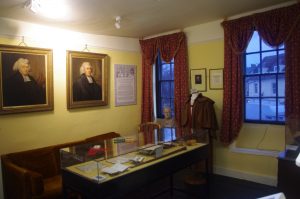
Amazing Grace – John Newton in Olney
A new room dedicated to John Newton’s life in Olney as curate of St Peter & St Paul. With his friend Cowper, they wrote hymns for the people of Olney – the most famous today being ‘Amazing Grace’
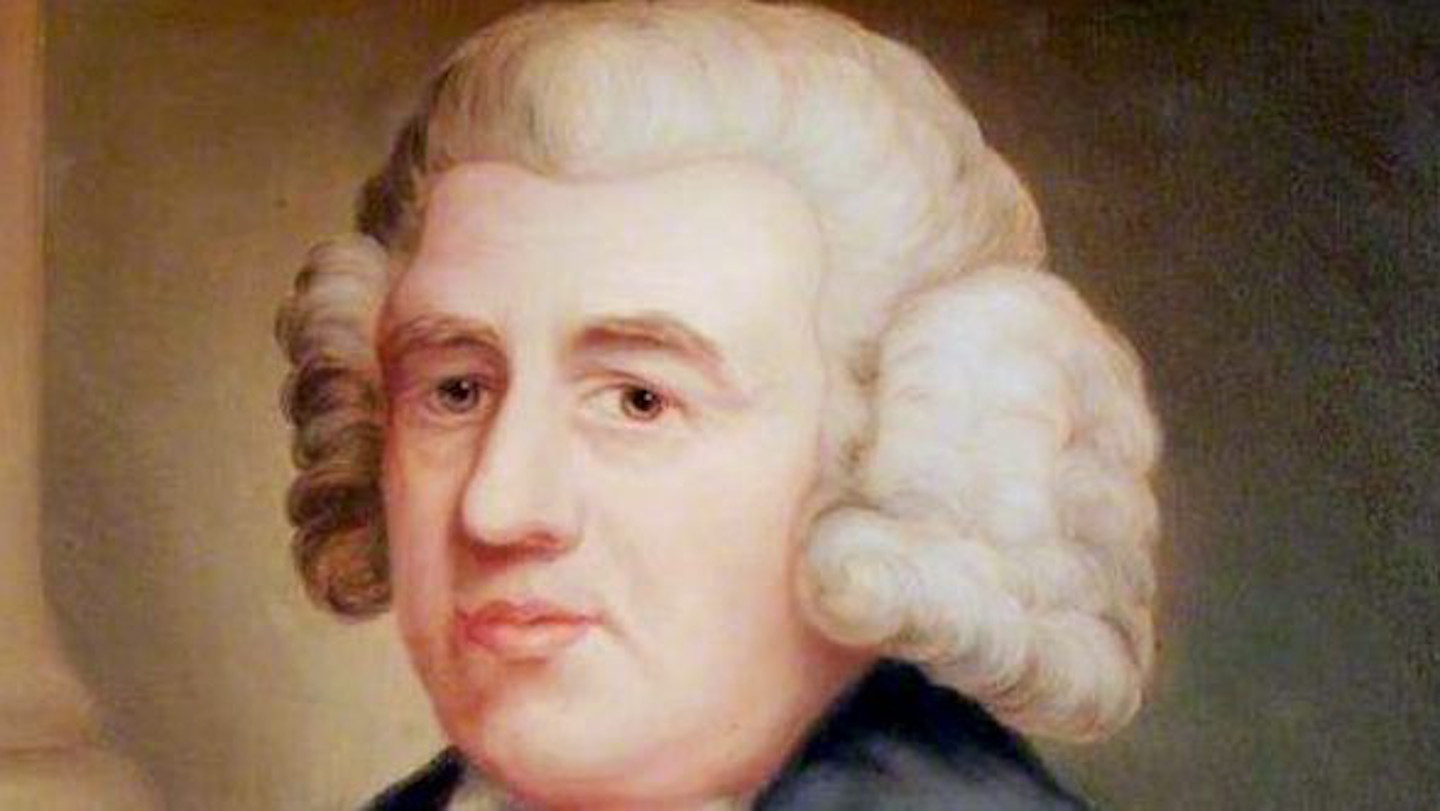
 Rev John Newton lived in Olney for nearly 16 years (1764 to 1779) as curate-in-charge of the parish church, St Peter & St Paul. He lived in the Vicarage opposite the church.
Rev John Newton lived in Olney for nearly 16 years (1764 to 1779) as curate-in-charge of the parish church, St Peter & St Paul. He lived in the Vicarage opposite the church.
‘The parish is large, the prospect pleasing and demands close attendance. Besides every day brings something unforeseen of its own …’
While he resided in Olney his writings became known worldwide.
Newton was a frequent visitor at Orchard Side to see his friend William Cowper and the two families socialised regularly.
“I believe … we were not seven hours without being together.”
Newton published several books while at Olney, the most famous perhaps being a joint-production with Cowper, the ‘Olney Hymns’ in 1779.
Many of their hymns are still sung today around the world:
As Newton wrote in the Preface:
“I more particularly dedicate to my dear friends in the parish and neighbourhood of Olney, for whose use the hymns were originally composed; as a testimony of the sincere love I bear them…”
Today one of the hymns Newton wrote in Olney, ‘Amazing Grace’, holds world records! The Library of Congress has more than 3,000 different recordings of ‘Amazing Grace’.
Discover more about the Olney Hymns and the hymn Amazing Grace.
Discover more about the life of John Newton in this virtual exhibition
‘I was born in London the 24th of July, 1725, old style. My parents, though not wealthy, were respectable.’ *
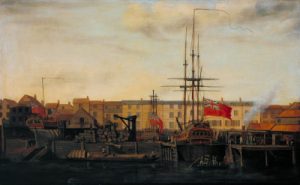
As a boy, John Newton lived in Red Lyon Street, Wapping not far from the Tower of London. (John Roque’s map of London 1746) His mother, Elizabeth Newton died when he was young and whilst his father was at sea.
‘My father was then at sea (he was a commander in the Mediterranean trade at that time) : he came home the following year, and soon after married again.’
After a few years at school, John Newton began his career as a seafarer with his father, Captain John Newton. He undertook 5 Mediterranean voyages, including a short and unsuccessful period in Alicante, Spain working for a merchant friend of his father.
‘ ; but my unsettled behaviour, and impatience of restraint, rendered that design abortive.‘
Through Joseph Manesty, a friend of John’s father, it was then arranged for him to go to Jamaica to be trained as a manager of a sugar plantation. At this time, this would have likely meant a plantation worked by enslaved people.
Prior to departure John paid a visit to the Catletts, distant cousins and in whose house his mother had died. Here he fell in love with Mary Catlett, known as Polly. John did not share his feelings with anyone but extended his stay and missed sailing to Jamaica.
‘Almost at the first sight of this girl (for she was then under fourteen), I was impressed with an affection for her which never abated or lost its influence a single moment in my heart from that hour.’
His father found him another position as a common sailor on a merchant ship, sailing between England and the continent. He returned to England and to the Catletts in Chatham at the end of the year – and again stayed longer with them then he should. Here, whilst walking, he was press-ganged by the Royal Navy
Thus began a period of his life where his love for Polly continually pulled him between the sea and land, and his behaviour waxed and waned as his hopes of marriage to her rose and fell.
March 1744: ‘HMS Harwich’, a ‘fourth-rate’ ship of the line of around 1000 tons with 50 guns and a complement of about 300 men.
December 1744: Rode to Chatham, hoping now to be considered as a prospective husband for Mary. The answer was No. Again he stayed longer than he should. On returning to the Harwich, although he only received a stern warning, he had lost favour with his Captain.
April 1745: The ship was about to sail to the East Indies for perhaps five years. Stopping in at Plymouth, John learnt that his father was nearby in Torbay. He left the ship without permission to ask his father to get him back into the African trade & give permission to marry Polly.
He was caught, imprisoned, whipped as punishment and degraded in rank.
May 1745: When the ‘Harwich’ was docked on the island of Madeira, John discovered that the Captain was exchanging men from another ship known as a Guinea trader.
(For more information about the HMS Harwich journey ‘Journal by James Mitchell, Captains Clerk’)
John’s behaviour did not improve on his new ship and he alienated himself from those in charge. Realising he had again put himself in danger, John took up the offer from another traveller, a Mr Evans, to join him in the land based slave trade around Sierra Leone.
Between 1745 – 7, John began his work for Mr Evans on the Plantain (Plantanes) Islands off the coast of Sierra Leone. This involved buying slaves, imprisoning them and selling them on to the slave ships.
John suffered ill health and also found himself at odds with his master.
‘I have sometimes been relieved by strangers; nay, even by the slaves in the chain, who have secretly brought me victuals (for they durst not be seen to do so.’
‘whenever he left the vessel, I was locked upon deck, with a pint of rice for my day’s allowance ; and, if he stayed longer, I had no relief till his return.’
This continued for about 12 months but John managed to secretly send out letters to his father and to Polly.
Near the end of 1746 it was agreed for John to go & work for another slave trader: this brought him new clothes, food, money & freedom but thoughts of Mary were given up.
Meanwhile, after receiving John’s letters, his father had solicited the help of his old friend Joseph Manesty. Manesty asked his ship captains sailing to the area to search out John and bring him back home. In February 1747, the captain of the ‘Greyhound’ was lucky enough to locate John and he joined the ship as they traded for gold, ivory, dyers-wood & bees-wax.
In January 1748, the journey back to England began. John had resumed his poor behaviour but had also started reading Thomas a Kempis’ book ‘The Christian Pattern. The Imitation of Christ’.
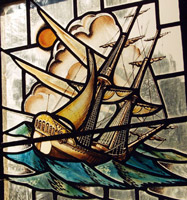
It was when returning to England aboard the ship the ‘Greyhound‘, John awoke to find himself caught in a violent storm and about to sink. He prayed for God’s mercy, the storm died down and after four more weeks at sea the Greyhound finally made it to port in Lough Swilly in Ireland. This experience marked the beginning of his journey back to his faith. Newton continued to work in the slave trade but his actions began to be shaped by his faith.
‘The 10th (that is in the present style the 21st) of March, is the day much to be remembered by me, and I have never suffered it to pass wholly unnoticed since the year 1748.’
On returning to England John discovered that his father was now supporting his marriage to Polly.
‘‘.., I found I had only the consent of one person to obtain; with her I as yet stood at as great an uncertainty as on the first day I saw her.’
John returned to sea and for the next five years was an active participant in the transatlantic slave trade.
August 1748 – December 1749: First Mate of the slave ship ‘The Brownlow’.
12th February 1750: Marriage to Mary (Polly) Catlett at St Margaret’s Rochester.
August 1750 – October 1751: Captain of the slave ship ‘The Duke of Argyle’
June 1752 – August 1753: Captain of the slave ship ‘The African’
October 1753 – August 1754: Captain of the slave ship ‘The African’ Whilst berthed at St Kitts, an island in the West Indies, he met Alexander Clunie. Clunie was the Captain of a merchant ship and also a member of the Dissenters’ Chapel in London. John and he spent many hours discussing prayer, faith and the Bible.
November 1754: A fit ended his sea career.
During the next few months, John returned to health and the search for a new job began. Also, following Captain Clunie’s advice, he attended Stepney Dissenting Chapel and travelled further around London to listen and talk to other renowned evangelical Gospel preachers.
In 1755, John took the job of Tide Surveyor at the Port of Liverpool. This coincided with a the Seven Year War which reduced maritime traffic, giving him time to meet with preachers and evangelists such as George Whitefield and John Wesley. ** see link below to find out more about Newton’s life in Liverpool
By 1757 Newton was considering joining the ministry himself. In 1758 he spent 6 weeks thinking, seeking advice and guidance and above all praying about this, as well as writing down his ‘Miscellaneous Thoughts‘ in a notebook. On his thirty-third birthday, his decision was finally made.
‘However, it was seven years before the Church of England agreed to his ordination. It was only with the support of William Legge, 2nd Earl of Dartmouth that this happened at all. Lord Dartmouth was Lord of the Manor of Olney and also held the living of the church of St Peter & St Paul. This connection then brought John Newton to Olney.
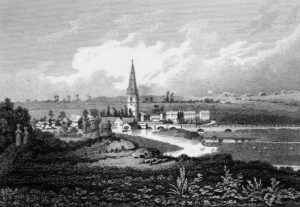 In 1764, he became curate of the parish church of St Peter & St Paul in Olney, a position he held for nearly 16 years.
In 1764, he became curate of the parish church of St Peter & St Paul in Olney, a position he held for nearly 16 years.
Sunday 27 May 1764
‘ Opened my commission in Olney Church in the morning from Psalm 80.1
In the afternoon 2 Corinthians 2:15,16
The vicarage house not being ready, we live for the present in an Inn’
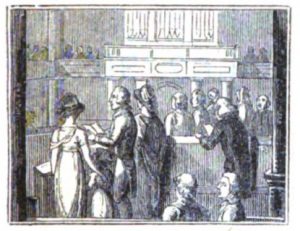
For John his Ministry went beyond Sunday church services.
‘As it is but a fortnight to the time I am to wait upon the Bishop, I shall defer setting up a weekly lecture ‘till that is over, …’
(Diary June 1764)
During his time in Olney his weekly pattern included two Sunday church services as well as fellowship, prayer groups & lectures in the Vicarage, Great House and the Church.
1st January 1765 John had described to his patron Lord Dartmouth his plans for developing his groups:
‘ I propose to establish three meetings … One for the children, another for the young and enquiring persons, and a third to be a meeting with the more experienced and judicious for prayer and conference.’
(Diary Jan 1765)
It was in 1767 that a chance meeting subsequently brought William Cowper & John Newton together in Olney. From this friendship came the writing partnership which led to the writing of hymns for the congregation. In 1779, these hymns were brought together and published as ‘The Olney Hymns’.
 John had hoped to be able to preach ‘extempore’ (without notes) but in the early years he found he would lose his flow and line of thought. At this point in his life he found he needed to prepare well and his practice was to first write out his thoughts in notebooks.
John had hoped to be able to preach ‘extempore’ (without notes) but in the early years he found he would lose his flow and line of thought. At this point in his life he found he needed to prepare well and his practice was to first write out his thoughts in notebooks.
It was for his New Year’s Day service in 1773 that John wrote the words for the hymn ‘Amazing Grace‘. The Museum owns several of John’s notebooks but Lambeth Palace owns the ‘Amazing Grace’ sermon notebook.
In 1780 Newton moved to the City of London as rector of St Mary Woolnoth Church, where he wholeheartedly supported the work of the Committee for the Abolition of the Slave Trade, formed in 1787.
‘I hope it will always be a subject of humiliating reflection to me, that I was once an active instrument in a business at which my heart now shudders.’
Published 1788 ‘Thoughts Upon the African Slave Trade’
The Minutes of the first meeting of the Committee for the Abolition of the Slave Trade can be read here.
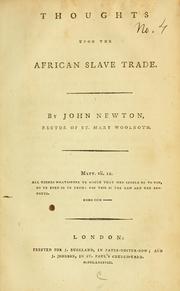 Other committee minutes record how they purchased the remains of the 1st print run of Newton’s Thoughts upon the African Slave Trade published in January 1788, paid for 3,000 more to be printed and sent a copy to each member of the House of Commons and the House of Lords.
Other committee minutes record how they purchased the remains of the 1st print run of Newton’s Thoughts upon the African Slave Trade published in January 1788, paid for 3,000 more to be printed and sent a copy to each member of the House of Commons and the House of Lords.
However, it was back in December 1785 that William Wilberforce, MP for Hull, had visited John for guidance and advice. They had first met in Olney when as an 11 year old boy William had accompanied his Uncle and Aunt. Through his meetings with John, William made the decision not to enter the ministry himself, but to remain an MP and become the voice of the abolitionist movement in parliament.
For further information on John’s involvement in both the Slave Trade and Campaign to Abolish Slavery visit our Slavery & Abolition page.
John Newton died in 1807, a few months after the Act abolishing the slave trade throughout the British Empire had been passed. 
Polly and John were originally buried in the crypt of his London church, St Mary, Woolnoth.
 However, in 1893 their remains were re-interred in the churchyard of St Peter & St Paul in Olney when work was done on the crypt of St Mary Woolnoth
However, in 1893 their remains were re-interred in the churchyard of St Peter & St Paul in Olney when work was done on the crypt of St Mary Woolnoth
The monument to Polly’s father, who spent his last years living with the couple at the Vicarage, can to seen to the left of the tomb.
John Newton’s writings were popular and widely read. Today he is perhaps best known as the author of the world-famous hymn, Amazing Grace, which was one of the Olney Hymns; but many of his letters were published in his lifetime and are still proving inspirational reading today.
* All quotes are taken from John’s autobiography ‘An Authentic Narrative’ published 1764
Letters to Benjamin Fawcett, circa 1762 : manuscript, in the hand of Samuel Cooper. These letters, in which Newton gives an account of his life, are a precursor to Newton’s letters to Thomas Haweis, which were published as An Authentic Narrative Of Some Remarkable And Interesting Particulars In The Life Of John Newton (London, 1764).
John Newton: Dissenting Minister
JOHN NEWTON’S DIARY: 1764 John Newton / The John Newton Project (Diary) ISBN: 978-0-9559635-1-3
John Newton 1767 diary : Lambeth Palace Library MS 2941 Transcription by Marylynn Rouse, The John Newton Project www.johnnewton.org
Journal of a Slave Trader (John Newton 1750-1754) Edited, with an introduction, by Bernard Martin and Mark Spurrell
The original journals are at the Royal Maritime Museum, Greenwich. Some digitised pages of the journal can be seen on their website.
** For more information on John Newton’s life in Liverpool, visit the Bygone Liverpool website
Letters from John Newton to the Earl of Dartmouth: Historical Manuscripts Commission XV Report, Appendix, Part 1, The Manuscripts of the Earl of Dartmouth, iii (1896 ) Cowper & Newton Museum
Letters to a Wife: By the Author of Cardiphonia by John Newton 1793
Digital images of some of the letters can be seen on the Lambeth Palace website.
The Christian correspondent; or A series of religious letters, written by John Newton to Captain Alexander Clunie, from 1761, to 1770
** John Newton: Tide Surveyor and the Boarding of the Betty
‘Ministry on My Mind’ by Marylynn Rouse and published by the John Newton Project
Digitised notebook ‘Miscellaneous Thoughts’ by John Newton Lambeth Palace
You can also read more about John Newton and his works on the ‘John Newton Project’ website.

A new room dedicated to John Newton’s life in Olney as curate of St Peter & St Paul. With his friend Cowper, they wrote hymns for the people of Olney – the most famous today being ‘Amazing Grace’
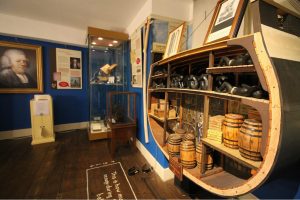
Charting John Newton’s childhood, experiences at sea, participation in the slave trade & courtship of Polly. Explore how a storm at sea affected his life & his journey from slave ship captain to abolitionist.
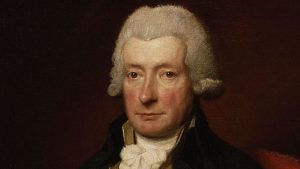
William Cowper (1731-1800), pronounced “Cooper”, was a renowned 18th century poet and translator of Homer. His most famous works include his 5000-line poem ‘The Task’ and some charming and light-hearted verses, not least ‘The Diverting History of John Gilpin’. Phrases he coined such as ‘Variety is the spice of life’ are still in popular use
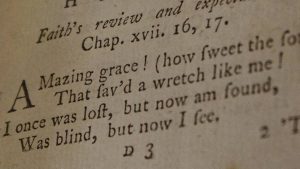
Amazing Grace & The Olney Hymns ‘to my dear friends in the parish and neighbourhood of Olney, for whose use the hymns were originally composed;…’ Did you know? ‘Amazing Grace’ was penned by the Rev John Newton during his time here in Olney. ‘Amazing Grace’ was originally titled ‘Faith’s Review and Expectation’ . It was published by John in
Receive our latest news and updates delivered straight to your inbox
Museum and Gardens - £10.00 (includes an annual pass)
Gardens only - £4
Children under 16 - FREE
Hours: 11.00 - 4.30 (last entry 3.30)
Days: Tuesday, Wednesday, Thursday, Friday and Saturday
Open 29th March 2024 on Good Friday
Last opening day of this season is Wednesday 18th December 2024
The Olney Hymns
The hymns written by Cowper and Newton may have been first sung at Newton’s meetings in the Great House. Two hymns, Cowper’s ‘Jesus, Where’er Thy People Meet’ and Newton’s ‘On Opening a Place for Social Prayer’ were written for the move of the Tuesday prayer meeting for adults into the largest room in the Great House in 1769.
Some of the hymns had been published in other publications before 1779. Amongst these were:
Oh! for a closer walk with God
God moves in a mysterious way
Safely through another week
Encouraged by thy word
‘Copies of a few of these Hymns have already appeared in periodical publications, and in some recent collections. I have observed one or two of them attributed to persons who certainly had no concern in them, but as transcribers. All that have been at different times parted with in manuscript are included in the present volume; and (if the information were of any great importance) the public may be assured, that the whole number were composed by two persons only.’
We only have a little information about the tunes to which the hymns were originally sung. To which are added hymns &c
An Authentic Narrative
An Authentic Narrative began in 1762 as eight letters to Benjamin Fawcett, a Presbyterian minister at Kidderminster, who had asked Newton to write down more about his eventful life.
Newton’s letters were then seen by an evangelical clergyman Rev Thomas Haweis. He saw their potential as a spiritual narrative for general readers and asked Newton to add more detail, which extended the number of letters to 14. Haweis arranged their publication. Newton’s name did not appear but he was soon known to be the author.
The book brought him to the notice of potential patrons, including Lord Dartmouth, who helped him secure ordination and appointed him to his first parish in Olney.
Model of a slave ship in cross-section, showing how enslaved people were transported to the Americas.
During his seafaring career John Newton had no scruples about the lawfulness of the slave trade.
From the 17th century onwards the demand for slave labour to work in the American colonies grew. Slavery had existed in Africa long before the Europeans arrived, but to satisfy demand traders searched far inland, devastating communities.
By the 18th century Britain, of all the European countries, was the most active in the trade. It is said that between 1640 and 1807, the year the British Parliament passed the Bill to abolish slave trading by British subjects, British ships had transported as many as 3.4 million Africans across the Atlantic.
Newton’s letter to his wife, written at sea
When Newton transcribed this letter for publication in Letters to a Wife, published in 1793 after Mary’s death, he omitted his mention of the slaves. Elsewhere in the book he describes his involvement in this ‘vile trade’.
“I felt the disagreeableness of the business very strongly. The office of a gaoler, and the restraints under which I was forced to keep my prisoners, were not suitable to my feelings; but I considered it as the line of life which God, in his providence had allotted me, and as a cross which I ought to bear with patience and thankfulness till he should be pleased to deliver me from it. Till then, I only thought myself bound to treat the slaves under my care with gentleness, and to consult their ease and convenience so far as was consistent with the safety of the whole family of whites and blacks on board my ship.”
Newton’s letter to his wife, written at sea, page 2
In Liverpool, as Newton was preparing a new ship, the Bee, to sail on the next slave trading journey, he suffered a seizure which forced him to look for work on land.
His next job was as Tide Surveyor in the Port of Liverpool, applying customs rules to incoming ships. The role left him time for self-education and his first attempts at preaching.
View of Olney Church, with Great House and Mill
It took Newton ten years after he retired from life at sea to be ordained as a Church of England minister. Ordination was difficult for anyone to achieve without a university degree.
In preparation for ordination Newton read and studied extensively, but his known connections to Rev John Wesley, Rev George Whitefield and other Gospel and Non-conformist ministers would not have helped his case. Mary’s family helped dissuade him from taking a post outside the established Church of England.
Market Place, Olney
Three years after the Newton’s arrived, William Cowper, Mrs Mary Unwin and her daughter moved into the handsome house on the centre right of the picture, now the Cowper & Newton Museum.
This was the beginning of a long acquaintance between the two men which resulted in the compilation of the Olney Hymns.
In 1796, a survey of the Market Place notes, ‘The Dwellings comprized in No 13 (the Market Place) are very old, they stand in the middle of Olney Street, and are rather a nuisance.’ These building included the town Lock Up (seen in the painting) and the Shiel Hall in which on the top floor a school was run.
‘The Town of Olney has a long Street of above half a Mile: at the Bottom stand the Church. The Market, which is on a Monday, is kept about the Middle of the Street, on a sort of a Square, there are good Shambles, but no Market House. The Fairs are on Easter Monday & St Peter’s Day June 29.’ Rev William Cole of Bletchley (1714 – 1782)
John Newton’s Writing Desk
When the Newtons moved from Olney to the City of London at the end of 1779, his furniture was put up for sale. This was more practical than depending on horse and cart to transport large items over long distances.
The desk appears in a later sale of household goods as having been John Newton’s, and on the reverse of the sliding writing panel is a handwritten note confirming his ownership
Amazing Grace, from the first edition of the Olney Hymns
The idea of writing a hymn to prepare an audience for a sermon was something Newton did regularly. The hymn’s original title was Faith’s Review and Expectation.
Through the 18th and 19th century, Amazing Grace was printed separately in some hymn compilations in England and Scotland, including, ‘A Select Collection of Hymns Universally Sung in all the Countess of Huntingdon’s Chapels. (1780)’ and ‘A Collection of Hymns for the use of the Protestant Church of the United Brethren’ (1789).
Its later fame though was owed to its popularity in America. The hymn was first published in New York in 1790 and became particularly popular at Christian revival meetings.
Church of St Mary Woolnoth, City of London
Newton quickly established himself as a popular gospel preacher and, as in Olney, the congregation of St Mary Woolnoth grew rapidly.
He also gave spiritual talks in the houses of influential Londoners, and continued the publication of his pastoral letters. In 1781 he published Cardiphonia, letters to prominent people in evangelical circles in London. The book was widely read.
Thoughts upon the African Slave Trade, John Newton, 1788
Newton’s identified written contribution to the abolition movement came about relatively late in his life. His involvement in the slave trade was not a topic he published in writing until the 1780s.
It is likely that he did discuss the slave trade with his friend William Cowper in Olney and many others in both Liverpool and London.
Cowper wrote about his opposition to slavery in his poems Charity (1782) and The Task (1784).
As a well-know published poet, he was also approached to write poems specifically for the abolition campaign: The Negro’s Complaint, Pity for Poor Africans, The Morning Dream and Sweet Meat has Sour Sauce: or, the Slave Trader in the Dumps were all written in 1788 although some did not appear in print until later.
Newton took no profits from the sale of this pamphlet, asking that revenue be paid to the Sunday School Society.
A detail from the model slave ship cross section
’11th December 1752
‘…By the favour of Divine Providence made a timely discovery today that the slaves were forming a plot for an insurrection. Surprised 2 of them attempting to get off their irons, and upon farther search in their rooms, upon the information of 3 of the boys, found some knives, stones, shot, etc, and a cold chissel.’
John Newton’s journal for the slave ship the African
The Olney Hymns, Preface
The early friendship between the two men was based on their faith. Cowper had aristocratic relatives and his background was very different to Newton’s. As a young man he suffered a severe breakdown. He found peace of mind helping Newton in the parish of Olney.
It is likely that Cowper’s hymns were written in the early 1770s. On New Year’s Day 1773, the day on which Newton preached his ‘Amazing Grace’ sermon, Cowper came close to suicide, believing that God had rejected him.
Cowper’s career as a poet took off only in the 1780s.
Interior of Olney Church, showing the gallery constructed in 1765
Newton wrote to his friend Clunie in February 1765, ‘A plan has been made, and the estimate is eighty-five pounds – to have four depths of handsome pews, and an open seat behind …I intend to have the best front seat for the accommodation of my friends’.
Newton subscribed five guineas to the cost, although he could barely afford it.
A guest at the vicarage in 1766: Samson Occom
Newton’s diary for June 1766* reads, ‘I went in the post-chaise and brought Mr Occom the Indian from Northampton; he preached in the evening to a great auditory for so short a warning. Meeting House and yard quite full … he said many striking things of the Lord’s work in America’
After the visit Occom recorded in his diary, ‘this Mr Newton is a Minister of the Church of England; he was a sailor and God marvellously turned him and he is a flaming Preacher of the Gospel’
* John Newton’s 1766 diary edited by Marylynn Rouse, 2022.
Picture credit: The National Portrait Gallery.
Olney Vicarage
Olney’s vicar in Newton’s time was Rev Moses Browne, an absentee in London who refused to surrender the income from his Olney living.
As curate, Newton maintained a regular pattern of church services, including two services on Sunday. He frequently preached elsewhere, travelling on horseback considerable distances from Olney.
Unusually for an Anglican minister he was happy to speak at the Baptist and Independent meetings in Olney.
Storm at sea
Newton’s friend Richard Cecil began writing this biography shortly before Newton died and with his endorsement. Like Newton, Cecil was a founder member of an evangelical Anglican group known as the Eclectic Society. They sometimes met in the vestry of Cecil’s church in Bedford Row in London. The anti-slavery campaigner and Member of Parliament William Wilberforce was to become a member.
‘The 10th (that is in the present stile the 21st) of March, is the day much to be remembered by me, and I have never suffered it to pass wholly unnoticed since the year 1748. On that day the Lord sent from on high and delivered me out of deep waters.’
An Authentic Narrative
Birth of Mary Newton recorded in the Catlett Family Bible
Mary’s younger brother, named George after his father, died in 1774 leaving an infant daughter Elizabeth (Betsy). She was adopted by the Newtons and came to live in Olney. John and Mary had no children of their own and Betsy was much loved. She later looked after Newton in his old age.
A second child Eliza joined the Newtons’ London household in 1783. She was the surviving daughter of Mary’s sister Elizabeth. To Newton’s great grief Eliza died aged 14 of consumption, the same illness that had killed her parents and brother.
The Catlett Family Bible
Mary’s mother Elizabeth Churchill had been a close friend of John Newton’s mother. Some years after her death the Catletts invited Elizabeth’s son John to visit them in Chatham. In December 1742 the 18-year old John Newton knocked on their door and met 13-year old Mary. For Newton it was the beginning of a love affair that lasted his entire life. He described in An Authentic Narrative how his passion to see Mary led to him being press-ganged onto a Royal Navy ship.
When Newton returned to England from Sierra Leone aboard the Greyhound in 1748, both the Catlett and Newton families finally agreed the two could marry.
A fold out map of the coast of Guinea, West Africa
Newton first arrived in West Africa in 1745 as a crew member on a merchant ship. After his poor behaviour alienated him from those in charge, he left the ship with a Mr Evans, to work for him as a land based slave trader. His new employer built a slave compound, or factory, on the Plantane Islands, just off the coast of Sierra Leone.
Later Newton was given permission to work for another slave trader and moved to Kittam.
‘If you cast your eyes upon a large map of Africa while you are reading this, you will have a general idea of the country I was in; for though the maps are very incorrect, most of the places I have mentioned are inserted, and in the same order as I have named them.’
An Authentic Narrative
Newton first visited West Africa in 1745 on a merchant ship, the Pegasus. Newton’s behaviour was so bad that he fell out with the captain. When the ship departed for the West Indies, Newton chose to stay behind to make his fortune working with a slave trader Amos Clow.
Clow had a slave compound, or factory, on the Plantane Islands, just off the coast of Sierra Leone. Newton spent months there in captivity.
An Authentic Narrative was based on some early letters that Newton wrote about his seafaring life when he was studying for ordination. Newton described his childhood, his early adventures and emergence as captain of a slave-trading ship.
The book was written long before Newton’s participation in the abolitionist campaign. Although he says that he himself was treated like a slave when he started working on the West African coast, the book shows little sympathy for enslaved Africans.
Newton’s letters were seen by an evangelical clergyman Thomas Haweis, who saw their potential as a spiritual narrative for general readers. Haweis arranged their publication. Newton’s name did not appear but he was soon known to be the author. The book brought him to the notice of potential patrons, including Lord Dartmouth, who helped him secure ordination and appointed him to his first parish in Olney.
Our Museum building remains CLOSED. We are opening our gardens on limited entry. The Cowper & Newton Museum gardens will be open to welcome you on Wednesday 5th August 10.30 – 12.15 and Saturday 8th August 10.30 – 12.15
(Follow our social media accounts or check back here for further opening days & times as they become available)
